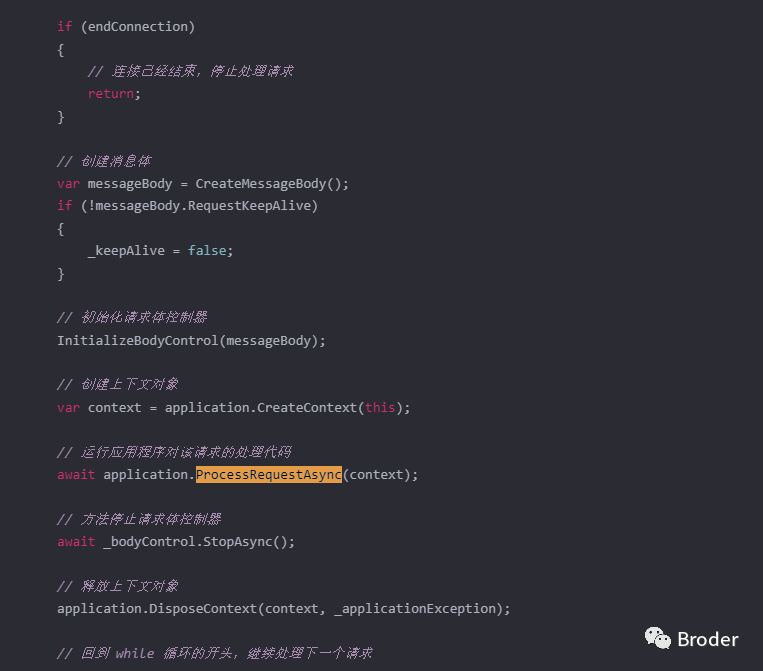.NET本身就是一个基于中间件(middleware)的框架,它通过一系列的中间件组件来处理HTTP请求和响应。在之前的文章《.NET源码解读kestrel服务器及创建HttpContext对象流程》中,已经通过源码介绍了如何将HTTP数据包转换为.NET的HttpContext对象。接下来,让我们深入了解一下.NET是如何设计中间件来处理HttpContext对象。.
通过本文,您可以了解以下内容:
-
认识中间件的本质 -
实现自定义中间件 -
源码解读中间件原理
一、重新认识中间件
1. 中间件的实现方式
在介绍中间件之前,让我们先了解一下管道设计模式:
管道设计模式是一种常见的软件设计模式,用于将一个复杂的任务或操作分解为一系列独立的处理步骤。每个步骤按特定顺序处理数据并传递给下一个步骤,形成线性的处理流程。每个步骤都是独立且可重用的组件。
在.NET中,针对每个HTTP请求的处理和响应任务被分解为可重用的类或匿名方法,这些组件被称为中间件。中间件的连接顺序是特定的,它们在一个管道中按顺序连接起来,形成一个处理流程。这种设计方式可以根据需求自由地添加、删除或重新排序中间件。
中间件的实现非常简单,它基于一个委托,接受一个HttpContext对象和一个回调函数(表示下一个中间件)作为参数。当请求到达时,委托执行自己的逻辑,并将请求传递给下一个中间件组件。这个过程会持续进行,直到最后一个中间件完成响应并将结果返回给客户端。
/* * 入参1 string:代表HttpContext * 入参2 Func<Task>:下一个中间件的方法 * 结果返回 Task:避免线程阻塞 * **/Func<string, Func<Task>, Task> middleware = async (context, next) =>{ Console.WriteLine($"Before middleware: {context}");
await next(); // 调用下一个中间件
Console.WriteLine($"After middleware: {context}");};
Func<Task> finalMiddleware = () =>{ // 最后一个中间件的逻辑 Console.WriteLine("Final middleware"); return Task.CompletedTask;};为了给所有的中间件和终端处理器提供统一的委托类型,使得它们在请求处理管道中可以无缝地连接起来。所以引入了RequestDelegate委托。上文中Func方法,最终都会转换成RequestDelegate委托,这一点放在下文源码解析中。
public delegate Task RequestDelegate(HttpContext context);2. 中间件管道构建器原理
下面是从源码中提取出的一个简单的中间件管道构建器实现示例。它包含一个 _middlewares 列表,用于存储中间件委托,并提供了 Use 方法用于添加中间件,以及 Build 方法用于构建最终的请求处理委托。
这个实现示例虽然代码不多,但却能充分展示中间件的构建原理。你可以仔细阅读这段代码,深入理解中间件是如何构建和连接的。
public class MiddlewarePipeline{ private readonly List<Func<RequestDelegate, RequestDelegate>> _middlewares = new List<Func<RequestDelegate, RequestDelegate>>();
public void Use(Func<RequestDelegate, RequestDelegate> middleware) { _middlewares.Add(middleware); }
public RequestDelegate Build() { RequestDelegate next = context => Task.CompletedTask; for (int i = _middlewares.Count - 1; i >= 0; i--) { next = _middlewares[i](next); }
return next; }}二、实现自定义中间件
如果您想了解中间件中Run、Use、Map、MapWhen等方法,可以直接看官方文档:https://learn.microsoft.com/zh-cn/aspnet/core/fundamentals/middleware/?view=aspnetcore-7.0
1. 使用内联中间件
该中间件通过查询字符串设置当前请求的区域性:
using System.Globalization;
var builder = WebApplication.CreateBuilder(args);var app = builder.Build();
app.UseHttpsRedirection();
app.Use(async (context, next) =>{ var cultureQuery = context.Request.Query["culture"]; if (!string.IsNullOrWhiteSpace(cultureQuery)) { var culture = new CultureInfo(cultureQuery);
CultureInfo.CurrentCulture = culture; CultureInfo.CurrentUICulture = culture; }
// Call the next delegate/middleware in the pipeline. await next(context);});
app.Run(async (context) =>{ await context.Response.WriteAsync( $"CurrentCulture.DisplayName: {CultureInfo.CurrentCulture.DisplayName}");});
app.Run();2.中间件类
以下代码将中间件委托移动到类: 该类必须具备:
-
具有类型为 RequestDelegate 的参数的公共构造函数。 -
名为 Invoke 或 InvokeAsync 的公共方法。 此方法必须: -
返回 Task。 -
接受类型 HttpContext 的第一个参数。 构造函数和 Invoke/InvokeAsync 的其他参数由依赖关系注入 (DI) 填充。
-
using System.Globalization;
namespace Middleware.Example;
public class RequestCultureMiddleware{ private readonly RequestDelegate _next;
public RequestCultureMiddleware(RequestDelegate next) { _next = next; }
public async Task InvokeAsync(HttpContext context) { var cultureQuery = context.Request.Query["culture"]; if (!string.IsNullOrWhiteSpace(cultureQuery)) { var culture = new CultureInfo(cultureQuery);
CultureInfo.CurrentCulture = culture; CultureInfo.CurrentUICulture = culture; }
// Call the next delegate/middleware in the pipeline. await _next(context); }}
// 封装扩展方法public static class RequestCultureMiddlewareExtensions{ public static IApplicationBuilder UseRequestCulture( this IApplicationBuilder builder) { return builder.UseMiddleware<RequestCultureMiddleware>(); }}3. 基于工厂的中间件
上文描述的自定义类,其实是按照约定来定义实现的。也可以根据IMiddlewareFactory/IMiddleware 中间件的扩展点来使用:
// 自定义中间件类实现 IMiddleware 接口public class CustomMiddleware : IMiddleware{ public async Task InvokeAsync(HttpContext context, RequestDelegate next) { // 中间件逻辑 await next(context); }}
// 自定义中间件工厂类实现 IMiddlewareFactory 接口public class CustomMiddlewareFactory : IMiddlewareFactory{ public IMiddleware Create(IServiceProvider serviceProvider) { // 在这里可以进行一些初始化操作,如依赖注入等 return new CustomMiddleware(); }}
// 在 Startup.cs 中使用中间件工厂模式添加中间件public void Configure(IApplicationBuilder app){ app.UseMiddleware<CustomMiddlewareFactory>();}
详细具体的自定义中间件方式请参阅官方文档:https://learn.microsoft.com/zh-cn/aspnet/core/fundamentals/middleware/write?view=aspnetcore-7.0
三、源码解读中间件
以下是源代码的部分删减和修改,以便于更好地理解
1. 创建主机构建器
为了更好地理解中间件的创建和执行在整个框架中的位置,我们仍然从 Program 开始。在 Program 中使用 CreateBuilder 方法创建一个默认的主机构建器,配置应用程序的默认设置,并注入基础服务。
// 在Program.cs文件中调用var builder = WebApplication.CreateBuilder(args);CreateBuilder方法返回了WebApplicationBuilder实例
public static WebApplicationBuilder CreateBuilder(string[] args) => new WebApplicationBuilder(new WebApplicationOptions(){ Args = args });在 WebApplicationBuilder 的构造函数中,将配置并注册中间件
internal WebApplicationBuilder(WebApplicationOptions options, Action<IHostBuilder>? configureDefaults = null){ // 创建BootstrapHostBuilder实例 var bootstrapHostBuilder = new BootstrapHostBuilder(_hostApplicationBuilder);
// bootstrapHostBuilder 上调用 ConfigureWebHostDefaults 方法,以进行特定于 Web 主机的配置 bootstrapHostBuilder.ConfigureWebHostDefaults(webHostBuilder => { // 配置应用程序包含了中间件的注册过程和一系列的配置 webHostBuilder.Configure(ConfigureApplication); });
var webHostContext = (WebHostBuilderContext)bootstrapHostBuilder.Properties[typeof(WebHostBuilderContext)]; Environment = webHostContext.HostingEnvironment;
Host = new ConfigureHostBuilder(bootstrapHostBuilder.Context, Configuration, Services); WebHost = new ConfigureWebHostBuilder(webHostContext, Configuration, Services);}ConfigureApplication 方法是用于配置应用程序的核心方法。其中包含了中间件的注册过程。本篇文章只关注中间件,路由相关的内容会在下一篇文章进行详细解释。
private void ConfigureApplication(WebHostBuilderContext context, IApplicationBuilder app){ Debug.Assert(_builtApplication is not null);
// 在 WebApplication 之前调用 UseRouting,例如在 StartupFilter 中, // 我们需要移除该属性并在最后重新设置,以免影响过滤器中的路由 if (app.Properties.TryGetValue(EndpointRouteBuilderKey, out var priorRouteBuilder)) { app.Properties.Remove(EndpointRouteBuilderKey); }
// ...
// 将源管道连接到目标管道 var wireSourcePipeline = new WireSourcePipeline(_builtApplication); app.Use(wireSourcePipeline.CreateMiddleware);
// ..
// 将属性复制到目标应用程序构建器 foreach (var item in _builtApplication.Properties) { app.Properties[item.Key] = item.Value; }
// 移除路由构建器以清理属性,我们已经完成了将路由添加到管道的操作 app.Properties.Remove(WebApplication.GlobalEndpointRouteBuilderKey);
// 如果之前存在路由构建器,则重置它,这对于 StartupFilters 是必要的 if (priorRouteBuilder is not null) { app.Properties[EndpointRouteBuilderKey] = priorRouteBuilder; }}通过新构建的RequestDelegate委托处理请求,在目标中间件管道中连接源中间件管道
private sealed class WireSourcePipeline(IApplicationBuilder builtApplication){ private readonly IApplicationBuilder _builtApplication = builtApplication;
public RequestDelegate CreateMiddleware(RequestDelegate next) { _builtApplication.Run(next); return _builtApplication.Build(); }}2. 启动主机,并侦听HTTP请求
从Program中app.Run()开始,启动主机,最终会调用IHost的StartAsync方法。
// Program调用Runapp.Run();
// 实现Run();public void Run([StringSyntax(StringSyntaxAttribute.Uri)] string? url = null){ Listen(url); HostingAbstractionsHostExtensions.Run(this);}
// 实现HostingAbstractionsHostExtensions.Run(this);public static async Task RunAsync(this IHost host, CancellationToken token = default){ try { await host.StartAsync(token).ConfigureAwait(false);
await host.WaitForShutdownAsync(token).ConfigureAwait(false); } finally { if (host is IAsyncDisposable asyncDisposable) { await asyncDisposable.DisposeAsync().ConfigureAwait(false); } else { host.Dispose(); } }}将中间件和StartupFilters扩展传入HostingApplication主机,并进行启动
public async Task StartAsync(CancellationToken cancellationToken){ // ...省略了从配置中获取服务器监听地址和端口...
// 通过配置构建中间件管道 RequestDelegate? application = null; try { IApplicationBuilder builder = ApplicationBuilderFactory.CreateBuilder(Server.Features);
foreach (var filter in StartupFilters.Reverse()) { configure = filter.Configure(configure); } configure(builder); // Build the request pipeline application = builder.Build(); } catch (Exception ex) { Logger.ApplicationError(ex); }
/* * application:中间件 * DiagnosticListener:事件监听器 * HttpContextFactory:HttpContext对象的工厂 */ HostingApplication httpApplication = new HostingApplication(application, Logger, DiagnosticListener, ActivitySource, Propagator, HttpContextFactory, HostingEventSource.Log, HostingMetrics);
await Server.StartAsync(httpApplication, cancellationToken);
}IApplicationBuilder 提供配置应用程序请求管道的机制,Build方法生成此应用程序用于处理HTTP请求的委托。
public RequestDelegate Build(){ // 构建一个 RequestDelegate 委托,代表请求的处理逻辑 RequestDelegate app = context => { var endpoint = context.GetEndpoint(); var endpointRequestDelegate = endpoint?.RequestDelegate; if (endpointRequestDelegate != null) { throw new InvalidOperationException(message); }
return Task.CompletedTask; };
// 逐步构建了包含所有中间件的管道 for (var c = _components.Count - 1; c >= 0; c--) { app = _components[c](app); }
return app;}3. IApplicationBuilder作用及实现
这里对IApplicationBuilder做个整体了解,然后再回归上文流程。
IApplicationBuilder的作用是提供了配置应用程序请求管道的机制。它定义了一组方法和属性,用于构建和配置应用程序的中间件管道,处理传入的 HTTP 请求。
-
访问应用程序的服务容器(ApplicationServices 属性)。 -
获取应用程序的服务器提供的 HTTP 特性(ServerFeatures 属性)。 -
共享数据在中间件之间传递的键值对集合(Properties 属性)。 -
向应用程序的请求管道中添加中间件委托(Use 方法)。 -
创建一个新的 IApplicationBuilder 实例,共享属性(New 方法)。 -
构建处理 HTTP 请求的委托(Build 方法)。
public partial class ApplicationBuilder : IApplicationBuilder { private readonly List<Func<RequestDelegate, RequestDelegate>> _components = new(); private readonly List<string>? _descriptions;
/// <summary> /// Adds the middleware to the application request pipeline. /// </summary> /// <param name="middleware">The middleware.</param> /// <returns>An instance of <see cref="IApplicationBuilder"/> after the operation has completed.</returns> public IApplicationBuilder Use(Func<RequestDelegate, RequestDelegate> middleware){ _components.Add(middleware); _descriptions?.Add(CreateMiddlewareDescription(middleware));
return this; }
private static string CreateMiddlewareDescription(Func<RequestDelegate, RequestDelegate> middleware){ if (middleware.Target != null) { // To IApplicationBuilder, middleware is just a func. Getting a good description is hard. // Inspect the incoming func and attempt to resolve it back to a middleware type if possible. // UseMiddlewareExtensions adds middleware via a method with the name CreateMiddleware. // If this pattern is matched, then ToString on the target returns the middleware type name. if (middleware.Method.Name == "CreateMiddleware") { return middleware.Target.ToString()!; }
return middleware.Target.GetType().FullName + "." + middleware.Method.Name; }
return middleware.Method.Name.ToString(); }
/// <summary> /// Produces a <see cref="RequestDelegate"/> that executes added middlewares. /// </summary> /// <returns>The <see cref="RequestDelegate"/>.</returns> public RequestDelegate Build(){ RequestDelegate app = context => { // If we reach the end of the pipeline, but we have an endpoint, then something unexpected has happened. // This could happen if user code sets an endpoint, but they forgot to add the UseEndpoint middleware. var endpoint = context.GetEndpoint(); var endpointRequestDelegate = endpoint?.RequestDelegate; if (endpointRequestDelegate != null) { var message = $"The request reached the end of the pipeline without executing the endpoint: '{endpoint!.DisplayName}'. " + $"Please register the EndpointMiddleware using '{nameof(IApplicationBuilder)}.UseEndpoints(...)' if using " + $"routing."; throw new InvalidOperationException(message); }
// Flushing the response and calling through to the next middleware in the pipeline is // a user error, but don't attempt to set the status code if this happens. It leads to a confusing // behavior where the client response looks fine, but the server side logic results in an exception. if (!context.Response.HasStarted) { context.Response.StatusCode = StatusCodes.Status404NotFound; }
// Communicates to higher layers that the request wasn't handled by the app pipeline. context.Items[RequestUnhandledKey] = true;
return Task.CompletedTask; };
for (var c = _components.Count - 1; c >= 0; c--) { app = _components[c](app); }
return app; }
}回归上文流程,将生成的管道传入HostingApplication中,并在处理Http请求时,进行执行。
// Execute the requestpublic Task ProcessRequestAsync(Context context){ return _application(context.HttpContext!);}还是不清楚执行位置的同学,可以翻阅《.NET源码解读kestrel服务器及创建HttpContext对象流程》文章中的这块代码来进行了解。

四、小结
.NET 中间件就是基于管道模式和委托来进行实现。每个中间件都是一个委托方法,接受一个 HttpContext 对象和一个 RequestDelegate 委托作为参数,可以对请求进行修改、添加额外的处理逻辑,然后调用 RequestDelegate 来将请求传递给下一个中间件或终止请求处理。
